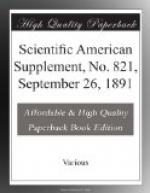The hygroscopic nature of dextrins renders them unsuitable for foreign work, but when the quantity of starch is appreciable, better results are obtainable. A large percentage of unaltered starch is usually accompanied with a small percentage of sugar, and no doubt this is the explanation of this fact. An admixture containing natural gum of course behaved better than when no such gum is present. Bodies like “arabol” made up with water and containing gelatin are very hygroscopic when dry, although as sold they lose water on exposure to the air. Gum substitutes consisting entirely of some form of gelatin with water, like fish glue, are also somewhat hygroscopic when dried. The behavior of these artificial gums and dextrins on exposure to a warm moist atmosphere can be determined in the same apparatus as described for gums.
The process we have adopted for estimating the glucose starch and dextrin in commercial gum substitutes is based on C. Hanofsky’s method for the assay of brewers’ dextrins (this Journal, 8, 561). A weighed quantity of the dextrin is dissolved in cold water, filtered from any insoluble starch, and then the glucose determined directly in the clear filtrate by Fehling’s solution. The real dextrin is determined by inverting a portion of the filtered liquid with HCl, and then determining its reducing power. The starch is estimated by inverting a portion of the solid dextrin, and determining the glucose formed by Fehling. After deducting the amounts due to the original glucose and the inverted dextrin present, the residue is calculated as starch. A determination of the acidity of the solution is also made with decinormal soda, and results returned in number of c.c. alkali required to neutralize 100 grammes of the dextrin. Results we have obtained using this method are embodied in the following table:
ANALYSIS OF GUM SUBSTITUTES
----+---------+---------+--------+----------+-------+--
-----+--------- No.| Glucose.| Dextrin.| Starch.| Moisture.| Gum, | Ash. |Acidity. | | | | | &c. | | ----+---------+---------+--------+----------+-------+-------
+--------- | | | | | | | cc. 1 | 8.92 | 81.57 | 1.99 | 10.12 | None | 0.207 | 57.3 2 | 7.19 | 71.46 | 13.13 | 10.40 | None | 0.120 | 44.8 3 | 1.29 | 69.42 | 24.72 | 4.17 | 1.12 | 0.280 | 5.22 4 | 8.40 | 60.98 | 10.98 | 10.09 | 9.02 | 0.530 | 20.0 5 | 10.60 | 44.98 | 8.05 | 12.20 | 23.57 | 0.600 | 52.0 6 | 14.80 | 11.57 | 36.46 | 34.87 | 1.89 | 0.580 | 8.0 7 | 8.00 | 29.61 | 26.78 | 33.98 | 0.88 | 0.750 | 88.0 8 | 2.29 | 52.38 | 37.65 | None | 7.335 | 0.315 | 9.6 ----+---------+---------+--------+----------+-------+-------
+---------
In those cases in which the substitute is made by admixture with gelatin or liquid glue the quantity of other organic matter obtained can be checked by a Kjeldahl determination of the total nitrogen. If a natural gum is added, it will be partially converted into sugar when the filtered liquid is inverted, and so make the dextrin determination slightly too high.




